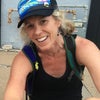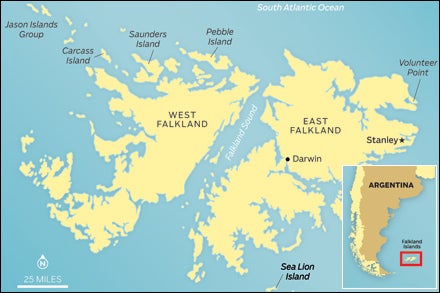My stomach is no match for the chop on this blustery January morning. Or the ripe stench of sea lions lazing in the sun on nearby Elephant Jason Island. Mike Clarke, the 56-year-old owner of the Condor, sailed this 53-foot trawler 8,237 miles back from Germany and never let the ocean get the best of him. But like every salty Falkland Islander I’ve met so far, Clarke, who’s bundled in a bright-red Mullion survival suit, is also a softie. When he realizes that I’ve just retched over the rail, he leaves the steering to his mate and offers me a cup of tea.
King penguins, Volunteer Point, East Falkland
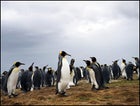 King penguins at Volunteer Point, East Falkland
King penguins at Volunteer Point, East FalklandKing cormorants, Falklands
 King cormorants, Tamar Point, Pebble Island
King cormorants, Tamar Point, Pebble IslandElephant seal, Falklands
 An elephant seal
An elephant sealKing penguins, Falklands
 King penguins, Volunteer Point
King penguins, Volunteer PointJonathan Shackleton
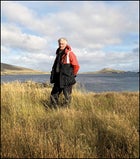 Jonathan Shackleton
Jonathan ShackletonPebble Island, Falklands
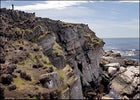 Pebble Island
Pebble IslandStriated Caracara, Falklands
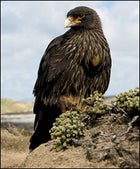 A striated caracara
A striated caracara@#95;box photo=image_2 alt=image_2_alt@#95;box
“You won’t see anything better than what you’ll see today!” says Clarke, trying to take my mind off the lurching boat. We’re motoring 30 miles from Carcass Island to Steeple Jason, which rises out of the South Atlantic like an Egyptian pyramid, to see more than 170,000 breeding pairs of endangered black-browed albatrosses. That’s one-third of the planetary population.
The more time I spend in the Falklands, the more I realize Charles Darwin and I differ. “It is a wretched place,” he wrote to his sister Caroline on April 6, 1834. “My excursion would have been longer; but during the whole time it blew a gale of wind with hail & snow…The whole country is more or less elastic peat bog.”
Darwin almost scared me off the Falklands. But after reading about the history and wildlife of this 740-island archipelago 300 miles east of Argentina, I grew obsessed with the raw, war-ravaged, penguin-rich country. On a shrinking globe, the Falklands seem to be one place where, as the country’s marketing slogan brags, “nature is still in charge.”
That’s evident as Clarke anchors the Condor and Zodiacs us over to Steeple Jason. Privately owned by the Bronx-based Wildlife Conservation Society, this 1,953-acre island is nearly impossible to get to, and drop-ins aren’t welcome. I’m here because I’ve tagged along with Clarke to pick up some scientists from Falklands Conservation, the country’s largest environmental organization. Two of its seven employees have been here for a week counting albatross and penguin chicks.
As Clarke checks up on a few repairs to the island’s research cabin, the scientists and I bushwhack through neck-high tussock grass and past sleeping sea lions to the albatross colony. After a few hundred yards, the sky fills with eight-foot wingspans like a flock of soaring 747’s. The tussock opens onto a long spit covered with thousands of mud albatross nests, which look like giant bundt cakes frosted in white bird dung. The mothers preen their half-baked downy chicks and serenely watch us as we tiptoe closer to the fray. Southern giant petrels, striated caracaras, and rockhopper penguins mingle with the albatrosses in one massive, harmonious bird commune. The animals collectively take a step closer to check us out. Having seen The Birds, I take a few steps back.
Unlike the ultra-regulated Gal├ípagos, the Falklands’ minuscule number of land-based tourists (1,716 last year) allows guests freedom to interact with wildlife. That, combined with the wide-open spaces and the difficulty in accessing sites, is why the Falklands have become a mandatory stop for extreme birders.
“Only lucky people get to go to Steeple Jason,” a local told me earlier this morning as the Condor picked us up from a pier on Carcass Island at 6 A.M. But I’m beginning to think that, of the 6.7 billion people in the world, some of the luckiest are the 2,478 Falkland Islanders.
IT TOOK ME a few days to figure that out. After a 90-minute flight from Punta Arenas, Chile, I landed at Mount Pleasant, the British military base on East Falkland, southwest of the capital of Stanley. For security reasons, the pilot warned us not to take photographs, and before the customs agent stamped my passport, I had to sign a form stating that I had “aero-medical evacuation to the value of at least $200,000.”
@#95;box photo=image_2 alt=image_2_alt@#95;box
For a seemingly insignificant dot on the map, the Falklands have a tumultuous history, with France, Spain, and England as major players. The French established the first colony, Port Louis, on East Falkland in 1764. A year later, oblivious to the French, the British built Port Egmont, on nearby Saunders Island. In 1766, Spain bought out France and moved in on the British, staking their own claim to sovereignty. The two countries nearly came to blows because of the Falklands’ strategic location as a safe haven for ships battered by their passage around Cape Horn. In 1774, rumors of the impending Revolutionary War forced the British to withdraw, and the Spanish took over, ruling the Falklands from Buenos Aires until 1811, when they, too, pulled out due to financial constraints. In 1820 Argentina claimed sovereignty over the islands as a right of succession to Spain.
For the next 20 years, the islands saw shipwrecked sailors, scheming sea captains, foolhardy cattle entrepreneurs, and a few soldiers who murdered their Argentinian captain. In 1833, the British reasserted control, and by the mid-19th century, Stanley was an important port. Today, the islands are a self-governing United Kingdom Overseas Territory; 70 percent of the islands’ population is of British descent and the islanders are recognized as full British citizens.The Falklands might have happily floated into oblivion had it not been for Argentina’s April 2, 1982, invasion. Everything about the almost ten-week “conflict” was surreal, especially the time lapse in television coverage as a result of sketchy and highly restricted satellite transmissions. When British prime minister Margaret Thatcher finally unleashed a naval task force, seven weeks after the invasion, the British forces found some of the Falkland Islanders imprisoned in settlements and quickly running out of food. The Argentinian soldiers were so jumpy that if so much as a bird alighted outside a window, they would fire. Ultimately, the British forces overpowered Argentina, which surrendered on June 14, losing 649 soldiers to Britain’s 255, and has since vowed to never forcefully invade again. But relations are so frosty between the “Kelpers” (Argentinian for a Falkland Islander) and the “Bloody Argies” (Falkland Islander for an Argentinian) that Argentina allows only one flight per week to East Falkland through its airspace. (Miss your flight out and you’ll automatically extend your vacation.) To be on the safe side, Thatcher spent more than a billion pounds on a “Fortress Falklands” plan that included Mount Pleasant airfield, which houses 1,100 soldiers and has the islands’ only bowling alley and movie theater.
Why all the fuss over these windblown specks? Argentina claims it’s a sovereignty issue, and the Falkland Islanders claim it’s a right to self-determination, which would be noble. In reality, it also has a lot to do with oil. Nobody knows the amount of recoverable oil in the North Falklands Basin, but exploration company estimates have been as high as several billion barrels. “Shell estimated that 60 billion barrels of hydrocarbons may have been generated in the northern basin, where a drilling program is planned,” says Phyl Rendell, from the Falkland Islands Department of Mineral Resources. “Much of it could have leaked away, but it is an indicator that hydrocarbons are in the basin.”
Signs of the war are still everywhere. Along the only paved road in the Falklands, a 37-mile stretch that leads from the airport to Stanley, red-and-white signs marked with a skull and crossbones stick haphazardly out of the ground. The small type reads SLOW: MINEFIELD. The Argentinians planted an estimated 18,000 to 30,000 plastic land mines, and the many that remain are around the capital. It’s illegal to enter a minefield, but there are still casualties. A cow blew up in July 2007. (“It rattled all the windows in Stanley,” one local told me.) Before that, a visiting yacht neglected to pick up the Ports and Harbors Information Book and mistakenly landed on a pristine, yet heavily mined, beach. Indoctrinated locals would’ve stood frozen in place until a helicopter could’ve airlifted them off the sand, but the yachties took the risk and hightailed it back to their dinghy. Just outside of Stanley, an entire stretch of dunes is designated for blowing up found ordnance.
If I hadn’t flown from Punta Arenas, the only other way for an American like me to arrive would be to hop an Antarctica-bound cruise ship in South America. Last year, the country received more than 62,000 cruise-ship day-trippers. All of them land in Stanley or a few outlying, wildlife-rich islands, leaving the rest of the country untouched for the fly-in tourists, most of whom come to see the thousands of penguins.
With all due respect to the war, the Falklands are where Monty Python meets the Wild Kingdom. Life in Stanley, home to 2,115 of the islands’ residents, takes on a rogue British flair. The brightly colored tin roofs, red phone booths, and flapping Union Jacks are a quirky, cheerful antidote to the raw surroundings.
The day I arrived, the rain was falling almost horizontally as my taxi tailed a Land Rover with the bumper sticker WHERE THE HELL IS EASY STREET? We passed the Stanley Harbor, where the rusting iron hulk of the Lady Elizabeth, a 130-year-old three-masted schooner, listed on her side. We drove past the Globe Tavern, where the locals drink Boddingtons Draught in a can (there’s no tap beer here), passed a red double-decker bus and a sign for Thatcher Drive, then turned onto Drury Street to Kay’s B&B, a white house with a red tin roof and 79 smiling gnomes in the garden. The 160-year-old cottage has provided shelter to Japanese film crews, German explorers, and a Dutch backpacker who ended up marrying the former governor.
“I’m closin’ down, supposed to be retirin’, but I still have bookings for a year out,” said 72-year-old Kay McCallum as she greeted me with a cup of tea.
“Can you recommend a good restaurant?” I asked.
“I’m not a great deal of help there!” she said. “I’ve lived in Stanley for 40 years but have never been to any of the restaurants.”
Falkland Islanders are a solitary lot. When you live on an archipelago slightly larger than Connecticut, DIY becomes your modus operandi, a trait I’ll discover over and over again during my two-week visit to Stanley and “camp,” the term they use to describe the wilds beyond their civilized little capital.
The islanders have been pulling themselves up by their own bootstraps ever since Argentina invaded. In 1986, they established a world-class fishery, their largest revenue source (squid fishing alone generated ten million British pounds in license fees in 2008), which allowed them to sever most financial ties to Britain. Now the islanders have focused on finding ecologically responsible ways to entertain an increasing number of tourists lured by the promise of the last best free-ranging wildlife safari on the planet.
“I JUST LOVE this place,” Jonathan Shackleton tells me.
The author of Shackleton: An Irishman in Antarctica, the 58-year-old is a cousin to Lord Edward Shackleton, the youngest son of the famed Antarctic explorer Ernest. Lord Edward Shackleton authored “The Shackleton Report,” an important post-conflict document that encouraged Falkland Islanders to stop absentee land ownership by the United Kingdom and establish the 150-mile fishing zone.
@#95;box photo=image_2 alt=image_2_alt@#95;box
Jonathan, a strapping Irishman, is on his way to Antarctica as a lecturer aboard the Ocean Nova, a small luxury expedition cruise ship that caters mostly to well-heeled retirees. The ship has stopped off at Carcass, a 4,250-acre island 109 miles northwest of Stanley, so that the guests can get a taste of Falklands hospitality.
Rob McGill, a 65-year-old Falklands sheep farmer, bought Carcass in 1974. He has droopy eyes, massive forearms, and the snow-white hair of a wizard. His wife, Lorraine, has been up since 5 A.M. making chocolate ├ęclairs, shortbread, truffles, scones, and meringues for the cruise visitors. The water in the hourglass bay outside their farmhouse is so clear, the half-mile-long beach on the opposite end so white, and the sun so strong that we could be in the Caribbean if it weren’t for the gentoo penguins that keep popping out of the water and waddling to their colony, halfway up a precipitous hillside. I walk the beach with the Ocean Nova guests and watch them snap a few thousand digital photos.
“You can’t help but love the little buggers!” says Bob Eberle, a 79-year-old retired surgeon from Chicago. After the penguin photo shoot, the cruise passengers and Shackleton take off their knee-high rubbers and funnel into the McGills’ dining room for a sugary feast.
“My cousin Eddie had a real sympathy for the Falkland Islanders,” Shackleton says. “They have a very strong appreciation for roots and history, and they’re very determined and courageous people.”
Case in point: When the McGills aren’t hosting tea for tourists (35 boats and a few thousand people will stop this season), they tend 650 sheep, 26 cattle, six milk cows, two horses, and one dog. But there’s always room for more. “If we have a bed,” Rob tells me, “whoever comes first, we’ll be pleased to let them rent it.”
That seems to be the unspoken rule of the Falklands. A few days later, I fly to Saunders Island in a cherry-red twin-prop, a Falkland Islands Government Air Service (FIGAS) Britten Norman Islander. FIGAS has been the primary mode of travel between the main and outer islands since 1948. The five pilots fly in up to 55-knot winds but have racked up only one fatality in more than 60 years (and that was rumored to be the fault of a visiting pilot). FIGAS is so instrumental to the islanders that one of the country’s three radio stations announces the names and destinations of ticketed passengers the evening before the flight, which makes it hard to, ahem, fly under the radar.
The pilot makes a smooth landing on the grass airfield, and Suzan Pole-Evans, a stalwart 48-year-old Brit with salt-and-pepper hair, picks me up in her Land Rover. At 30,000 acres, Saunders is the fourth-largest island in the Falklands. It’s also the site of the first British settlement, Port Egmont. Anthony Pole-Evans, Suzan’s father-in-law and the island’s 90-year-old patriarch, has lived here since 1948. He’s “deaf as a post,” she says, “but he still likes to herd sheep.” Unlike other farmers, who’ve upgraded to four-wheelers, Suzan prefers herding their 6,000 Corriedale sheep on horseback┬Śand isn’t afraid to use her revolver.
Suzan drives me 12 miles over boulders, creeks, and tussock and through mud bogs┬Ś”This road is getting to me mentally, physically, and mechanically!” she says┬Śto the Neck. Watching penguins at the Neck is a little like people watching on a beach in Rio: Thousands of gentoo, rockhopper, Magellanic, and king penguins walk, squawk, nest, molt, defecate, mate, sun, and sleep in the sharp wind on this mile-long sand isthmus. For a penguin fanatic, the Neck is the holy grail.
“When I was little, I’d take a look at the old gentoos,” Suzan says, “but I can’t be bothered just for a pastime now.” Like most everyone in the Falklands, she works from sunup to sundown in the summer, herding sheep and running tourists.
When we return to the settlement, a cluster of five wind-bitten farmhouses with long views of the sea, Suzan drops me off at my home for two nights, a stone farmhouse built in 1874. I open the fridge and find 16 Beck’s beers. Sitting on a countertop nearby is their owner, Marcus Demuth. I read about the 40-year-old German kayaker in last week’s Penguin News (perhaps the last paper in the world with 98 percent readership among the locals), after he’d become the second man to circumnavigate the Falklands. He did it in 21 days and eight hours.
The first man to circumnavigate the Falklands did it in 2001. His name is Leiv Poncet, and he’s the 28-year-old son of French sailor Jerome Poncet, who was the first man to sail below the Antarctic Circle in a small yacht, in 1973. Jerome and his Australian wife, Sally, bought their own islands in the Falklands but keep their famous double-masted boats, the Golden Fleece and Damien II, moored to two shipwrecks in the Stanley Harbor when they’re in town.
Other than the Poncet family, the islands’ most famous athletes are likely the professional sheep shearers who pose for the Falklands’ annual in-the-buff calendar. For 2010 the shearing association was considering something a little different: a naked-rousie calendar, highlighting the hottest “rousie” women, who collect and clean the wool. The proceeds would go toward sending the islands’ top two shearers to the Golden Shears, the world championship in New Zealand.
“How was your trip?” I ask Demuth, who’s wearing a red stocking cap and looks worked.
“It was just brutal,” he says. “Really hard. Really, really hard. I’m in pure pain.”
To avoid the worst winds, Demuth paddled from 3 to 10 A.M. and from 6 to 10 p.m. every day. In King George Bay, south of Saunders off West Falkland Island, he was caught in a massive gale, capsized in a 30-foot wave, wet-exited, and crashed his kayak on an uninhabited island, where he went without water for 24 hours. When he regained his strength, he paddled into Saunders, where Anthony Tuson, the husband of Suzan Pole-Evans’s sister-in-law “Biffo” and a former pilot for the British Antarctic Survey, fixed his boat.
“These guys were just amazing,” says Demuth. “Without them, I probably couldn’t have finished the trip. I came back to work for them for free,” he says. “On Monday, I’m putting up the floorboards in the sheep shed and cleaning out the sheep shit!”
FOUR DAYS LATER, I’m back on East Falkland, driving with Alan Henry, the most hardcore of the islands’ birders, and a tall, thin British birder named Ben Hoare. We’re heading south from Stanley to a private farm in search of the elusive Hudsonian godwit and the flying steamer duck. We’re also trying to get out of town before the cruise crush buys out the stuffed-penguin supply. (A few thousand tourists are expected to disembark today.)
@#95;box photo=image_2 alt=image_2_alt@#95;box
“Here, if you want to find a rare bird, you go find it yourself,” says Henry. With two silver earrings, a military buzz cut, and the physique of a rugby player, Henry’s not your stereotypical twitcher. He keeps a blog on Falklands birding, which averages 123 hits per day, but he makes a living as a customs agent. In October 2008, he was involved in the largest drug bust in the history of the Falkland Islands when his dog sniffed out more than 28 kilos of coke on two Spanish fishermen en route to Spain.
As he drives, Henry, who’s also a trustee of Falklands Conservation, describes the breadth and depth of FC’s work. “If it’s got wings, legs┬Śor grows┬Śand it needs help, we’ll try to help it,” he says.
The nonprofit gets the majority of its almost $600,000 annual budget from research conservation grants. Its work includes extensive bird surveys, tussock conservation, rat eradication, community-awareness projects, and, most recently, the rehabilitation of dozens of penguins after a ship, the Ocean 8, sank in Berkeley Sound last May. The other conservation efforts in the archipelago are through voluntary startups like the Shallow Marine Surveys Group, a consortium of marine biologists, sailors, and boatsmen who volunteer to dive in 41-degree water to map, meter by meter, as much of the shallow marine life along the Falklands coastline as humanly possible┬Śa project never before tackled.
“Falklands is so unique because much of the land is privately owned, including internationally important areas of wildlife,” Sarah Crofts, Falklands Conservation’s community science officer, told me earlier. “Falklands Conservation has little jurisdiction over private landowners, but we are keen to promote the conservation and sustainable management of wildlife in harmony with existing land activities, like farming and tourism, and work alongside and with land owners.”
The land may be private, but you can ask the owner’s permission to traipse across it, as Henry did for our bird outing. After we drive past an abandoned farmhouse and open and close a half-dozen paddock gates, we come to what looks like Jurassic Beach. A few years ago, Henry found the carcass of an Andrew’s beaked whale here; there are no known sightings of the species alive in the wild. Henry lopped off the head and put it in his garden, leaving the intact skeleton on the sand, and DNA samples were sent to a lab in Australia. A few yards farther down are the bleached skeletons of 12 sperm whales. After a five-minute drive to another beach, we park the truck next to 14 massive elephant seals with bloodshot eyes.
“They look like they’ve been in the whisky,” says Henry. A little ways beyond, we find 17 more. Half a mile later, we find a lone king penguin on a pebble beach; there’s fuzz around its head where it hasn’t finished molting.
The silence is suddenly shattered by the rumbling scream of the Falklands’ biggest birds: two incoming Tornado fighter jets flying at mach speeds toward Mount Pleasant. That breaks the reverie, so we start down the bumpy track back toward Stanley. It’s been a fruitful outing. According to Henry, I’m one of only seven people who’s seen a Hudsonian godwit and a Hudsonian whimbrel in the Falklands on the same day.
That night, Hoare and I grab a can of Boddingtons at the Vic, the most happening spot in town. Besides us, five locals are drinking at the bar below a sign that reads THE BULLSHIT CORNER.
“The tourists are coming on Friday! Get your bloody hair cut!” says a guy wearing a silky nylon tracksuit to his tattooed buddy.
The bar has stopped serving food, so we step into the brisk summer evening. It’s 9 p.m. and light as day, but the streets are empty and the three nearby restaurants and the grocery store are closed. Tomorrow, 5,000 more cruise-shippers will flood this place. And just beyond the horizon, the bloody Argies will still be grumbling about their bloody sovereignty. But tonight, as the late-summer breezes die down and the moon rises over the shipwrecks in Stanley Harbor, the Kelpers have this hardscrabble paradise all to themselves.
Falklands Access & Resources:
WHEN TO GO: The summer tourist season runs October┬ľMarch. Expect a windier version of London’s climate, with highs in the mid-sixties, nightly lows in the forties, and sporadic rain. For more info, visit .
GETTING THERE: The only way to fly from the U.S. is via Santiago, and then on the once-every-Saturday LAN () flight via Punta Arenas, Chile, to Mount Pleasant (average price is $1,200 in the high season). American Airlines () flies nonstop to Santiago from Dallas and Miami.
OUTFITTERS: Montana-based ║┌┴¤│ď╣¤═° Life () offers three new land-based itineraries. Their popular Wildlife Week (from $3,050) gives you eight days to get among seabirds, penguins, albatrosses, sea lions, and other interesting creatures on Sea Lion, Saunders, and East Falkland islands. The eight-day Falkland Island Life (from $2,875) offers a mash-up of island wildlife, history, and culture on East Falkland, West Falkland, and Sea Lion islands. For a combo of those two trips, try their 15-day Falklands Quest (from $5,690).
CRUISES: The Ocean Nova, a 68-passenger ship operated by Quark Expeditions, was built in 1992 and recently refurbished. The 20-day adventure to Antarctica leaves from Ushu┬şaia, Argentina, and stops at the Falklands and South Georgia Island on the way. Doubles from $17,990; book through Quark () or ║┌┴¤│ď╣¤═° Life.
ACCOMMODATIONS: Expect to stay in B&Bs and family-run small hotels. Booking with an outfitter in advance is the best way to ensure a place to stay; ║┌┴¤│ď╣¤═° Life will handpick your hosts depending on what type of experience you want.
CONSERVATION: To learn more about Falklands wildlife, visit Falklands Conservation (), the Shallow Marine Surveys Group (), or Alan Henry’s birding blog (blogfalklandbirder).

